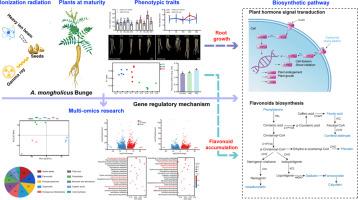辐射特异性代谢重编程驱动蒙古黄芪产量-质量平衡:来自伽马射线和重离子束照射的比较见解
IF 6.8
Q1 PLANT SCIENCES
引用次数: 0
摘要
生物量积累和次生代谢物生产之间的内在权衡仍然是药用植物驯化的根本挑战。虽然传统方法主要关注单性状的改进,但有效的并发优化策略仍未得到充分探索。本文采用γ射线(GR)和重离子束(HIB)辐照(200 Gy)对蒙古黄芪的栽培进行了开创性的比较研究,并结合转录组学和代谢组学综合分析,分析了它们对农艺性状和药用品质的差异影响。我们的研究结果表明,GR辐照是生物量增强的有效诱导剂,使鲜根重显著增加200%,同时使类黄酮含量提高20.2%。相比之下,HIB辐照对代谢重编程和基因调控的影响更为明显,尽管有适度的生长促进作用。多组学分析揭示了不同的分子机制:GR优先激活生长素信号通路和苯丙素生物合成,协调根发育和类黄酮积累,而HIB显著调节氨基酸代谢和次生代谢物生物合成途径。这种辐射特异性模式为次级代谢网络的调节提供了前所未有的见解。我们的研究为基于辐射的药用植物改良建立了一个新的范例- GR在生物量和初级生物活性化合物的增强方面具有优越的潜力,而HIB在操纵复杂的次级代谢方面具有独特的优势。这些发现为辐射技术在农艺策略中的精准应用提供了理论基础,这些农艺策略旨在利用激效效应促进药用植物生物活性化合物的积累,有效解决药用作物种植中持续存在的产量-质量悖论。本文章由计算机程序翻译,如有差异,请以英文原文为准。

Radiation-specific metabolic reprogramming drives yield-quality balance in Astragalus mongholicus: Comparative insights from gamma-ray and heavy-ion beam irradiation
The inherent trade-off between biomass accumulation and secondary metabolite production remains a fundamental challenge in medicinal plant domestication. While conventional approaches predominantly focus on single-trait improvement, effective strategies for concurrent optimization remain underexplored. Here we present a pioneering comparative investigation employing gamma-ray (GR) and heavy-ion beam (HIB) irradiation (200 Gy) in Astragalus mongholicus cultivation, coupled with integrated transcriptomic and metabolomic profiling to dissect their differential impacts on agronomic traits and medicinal quality. Our findings demonstrate GR irradiation as a potent inducer of biomass enhancement, achieving a remarkable 200% increase in fresh root weight while simultaneously elevating flavonoid content by 20.2%. In comparison, HIB irradiation exerted more pronounced impacts on metabolic reprogramming and genetic regulation despite moderate growth promotion. Multi-omics analysis revealed distinct molecular mechanisms: GR preferentially activated auxin signaling pathways and phenylpropanoid biosynthesis to coordinate root development and flavonoid accumulation, whereas HIB significantly modulated amino acid metabolism and secondary metabolite biosynthesis pathways. This radiation-specific pattern provides unprecedented insights into regulation of secondary metabolic networks regulation. Our study establishes a novel paradigm for radiation-based medicinal plants improvement - GR demonstrates superior potential for biomass and primary bioactive compound enhancement, while HIB offers unique advantages in manipulating complex secondary metabolism. These findings provide a theoretical foundation for precision application of radiation technologies in agronomic strategies aimed at enhancing bioactive compound accumulation in medicinal plants by leveraging the hormesis effect, effectively addressing the persistent yield-quality paradox in pharmaceutical crop cultivation.
求助全文
通过发布文献求助,成功后即可免费获取论文全文。
去求助
来源期刊

Plant Stress
PLANT SCIENCES-
CiteScore
5.20
自引率
8.00%
发文量
76
审稿时长
63 days
期刊介绍:
The journal Plant Stress deals with plant (or other photoautotrophs, such as algae, cyanobacteria and lichens) responses to abiotic and biotic stress factors that can result in limited growth and productivity. Such responses can be analyzed and described at a physiological, biochemical and molecular level. Experimental approaches/technologies aiming to improve growth and productivity with a potential for downstream validation under stress conditions will also be considered. Both fundamental and applied research manuscripts are welcome, provided that clear mechanistic hypotheses are made and descriptive approaches are avoided. In addition, high-quality review articles will also be considered, provided they follow a critical approach and stimulate thought for future research avenues.
Plant Stress welcomes high-quality manuscripts related (but not limited) to interactions between plants and:
Lack of water (drought) and excess (flooding),
Salinity stress,
Elevated temperature and/or low temperature (chilling and freezing),
Hypoxia and/or anoxia,
Mineral nutrient excess and/or deficiency,
Heavy metals and/or metalloids,
Plant priming (chemical, biological, physiological, nanomaterial, biostimulant) approaches for improved stress protection,
Viral, phytoplasma, bacterial and fungal plant-pathogen interactions.
The journal welcomes basic and applied research articles, as well as review articles and short communications. All submitted manuscripts will be subject to a thorough peer-reviewing process.
 求助内容:
求助内容: 应助结果提醒方式:
应助结果提醒方式:


